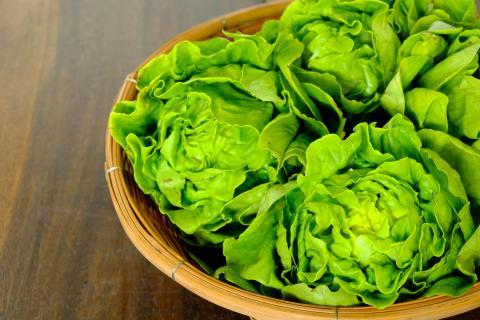
Butter lettuce is a member of the family Asteraceae, commonly known as the Aster family of the genus Lactuca L. or lettuce P. The United States Department of Agriculture lists butter lettuce as the species Lactuca sativa L. or garden lettuce P. This species contains three varieties—butter lettuce, Bibb, and Boston—that are so similar that they have become intertwined, but butter lettuce is the larger of the three. Lettuce dates back to 2680 B.C.E. in Egypt but butter lettuce was not developed until 1744 when it was bred from old lettuce known as Silesia. Butter lettuce is also known as butterhead lettuce and, as it is for all lettuce species, it is very low in calories but not lacking in nutrients. The leaves are packed with vitamins and minerals and the darker the leaves the higher the content and the more potent in preventing diseases. It is primarily a salad ingredient.
Butter lettuce grows in relatively large heads that are uniformly green in color. The leaves are tender with a slightly sweet taste, making it an ideal ingredient in sandwiches and wraps. To know how the leaf will taste, make a small scratch on the stalk to release the scent. The plant lends itself to containers, making it ideal for patio landscaping and indoor window decor.
Nutritional Benefits of Butter Lettuce
1. Butter lettuce is rich in vitamins A, C, and K. It is a good source of minerals that include iron, copper, potassium, and manganese. Other beneficial substances found in butter lettuce are flavonoids and antioxidants.
2. The vitamins in butter lettuce reduce the risk of developing diseases. The beta-carotene converts into vitamin A which maintains healthy skin, ocular system, and mucus membranes. Vitamin K keeps the skeletal system strong by increasing bone mass, thus reducing the risk of developing osteoporosis and other bone diseases. This vitamin is also beneficial to neurological health, decreasing the development of Alzheimer’s disease. Vitamin C strengthens the immune system, defending the body from infection, colds, and flu.
3. Rich in minerals, butter lettuce maintains a healthy body. The potassium found in the vegetable regulates blood pressure, reducing the risk of heart disease and stroke. Manganese is also present in butter lettuce, a mineral that is a catalyst with antioxidants to rid the body of free radicals, thus reducing the risk of developing cancers. The copper and iron that is contained in the plant helps the body to produce red blood cells vital to oxygenation.
4. The flavonoids and antioxidants found in butter lettuce are significant enough to prevent the development of lung and oral cavity cancers. It is valuable for pregnant women because of the folates present in the plant, resulting in the reduction of the incidents of neural tube defects in developing fetuses.
Growing Butter Lettuce
Add butter lettuce to your vegetable garden or as a decorative container plant. Butter lettuce seeds are very tiny and can be planted in the fall or in early spring as the plant is frost resistant. They can be sprinkled in rows and covered with one-quarter of an inch of soil. It is advised to water the soil before planting and after the seeds are in the ground and covered. They will begin to sprout in approximately ten days and once leaves develop in about six to eight weeks they can be harvested throughout the summer. It is advisable to keep the soil moist and to cover them during the heat of the day. Slugs and snails are a problem but can be removed at dusk when they emerge.








